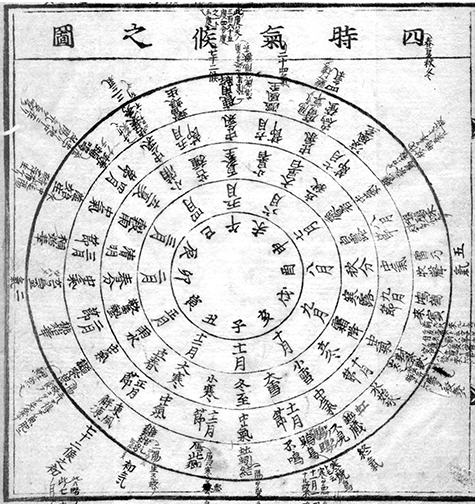
Qualities of the four seasons
By Robert L. Felt, Co-author Understanding Acupuncture
During this formative period, the idea of wind evolved. Wind had been considered the principal cause of illness since the most ancient times. From a self-willed spirit entity it evolved to an environmental phenomenon, just as Chinese civilization was transforming from a mythologically justified aristocracy to a secular nation. In the process of that transition, qi, subtle influences, was identified as the ground substance of all that is. Next, the human body came to be seen as relationships between functional units. Where in the West we describe organs as biological factories linked in an internal metabolic economy, China’s medical thinkers conceived extensive and poetic images that explained biological functions in social and political terms. The organs were divided into zang (“depots” in the language of the time) and fu (“palaces”), reflecting their role in a complex system of functional interactions.
The images and concepts used to describe this system were taken from the social and natural environments and often reflected the political state at the time of their conception. Chinese medical writers borrowed from social and philosophical vocabulary for processes that they found to be useful analogies to what goes on in the human body. Finally, through the great accomplishment of the Nan Jing author, the human organism came to be seen as linked in an endless circulation of qi. Thus the pathways of circulation, termed jing, would be named for the watercourses that were the high technology of the day, “conduits” or “channels.” This approach to anatomy and physiology resulted in most of the principles and some of the practices that survive in acupuncture today.
Theories supporting acupuncture would be elaborated throughout the ensuing centuries, yet “Chinese drug therapy” what is often called “herbal medicine” — would not be incorporated into the theoretical foundations of Chinese medicine for nearly a thousand years. However, by the end of the later Han dynasty (220 CE) the conceptual foundations of what we know as Chinese medicine today were thoroughly formed and recorded in documents that can be historically verified with a relatively high degree of certainty. Among these too are the Confuscian philosophical texts that provided the link between human behavior and human well-being that stimulated the development medical ideas distinct from demonology.
From this point forward, Chinese medicine would be elaborated by the many cultural, economic and political influences that molded Chinese culture as a whole. Although 220 to 589 CE, the Six Dynasties period, was an era of disunity, Buddhist influences were active in China and the medicine of systematic correspondence became more formal, developing an extensive technical literature. In the Sui Dynasty (590 to 617 CE), China was again united and Chinese culture, including an acupuncture that has many refined clinical details, spread throughout Asia. The Japanese in particular begin a conservative yet detailed absorption of Chinese medical ideas. Both Japan and Korea established state run medical colleges during this era.
In the Tang, from 618 to 960 CE, there came a period of cultural culmination, often thought of as China’s second golden age. It was a period of political unity, and Chinese medical ideas were diffused and absorbed throughout Asia. Medical thought, now strongly influenced by Daoism, came to be dominated by the search for academical immortality during a period of immense wealth and cultural fecundity. Of the twenty-two Tang emperors, seventeen died of experiments with immortality formulas. While this lead to little lasting medical innovation and the technical elements of acupuncture remained relatively unchanged, this period would see the advancement of knowledge concerning naturally-occurring drugs. Pine seeds and resin, chamomile, and the li-shi mushroom are among the medicines investigated, some of which retain an aura of their Tang reputation as longevity drugs until today.
Social and economic differentiation and specialization continued through the following Five Dynasties (907-960 CE) and Song (960 to 1274 CE) periods. Cultural specialization grew, guilds were formed, agricultural and commercial production expanded as new technologies came on line. Interdependence increased as cities, regions, trades and professions became more and more specialized. The period’s interest in details and refinements was matched by an increasing awareness and attention to the inter-relatedness of the whole and its components. Thus, in addition to the progress of secular studies, Confucianism and Daoism adopted this new scientism, while Buddhism declined relative to their success. In particular, the emerging qi-centered Neo-Confucian model successfully countered the Buddhist idea of the material world as pure illusion.
The notion that qi had always existed and that all things came in and out of existence as gatherings or dissolutions of qi achieved intellectual supremacy. Nevertheless, Daoist and Buddhist exorcisms as well as drug therapy joined acupuncture in being founded on systematic correspondence. At the beginning of the Song period there were nearly one hundred acupuncture texts, fifty physiological texts, and even seventy books devoted to diagnosis through the pulse alone. Less than ten of these works, however, followed Zhang Zhong-jing’s Han Dynasty ordering of drug treatments according to the principles of systematic correspondence. Thus, it is only in this period, a millennium past the Nan Jing that the qi paradigm would achieve dominance over all the branches of Chinese traditional medicine. Yin-yang, the five phases, the celestial stems and terrestrial branches, and the six climatic influences now permeated every branch of Chinese medicine.
